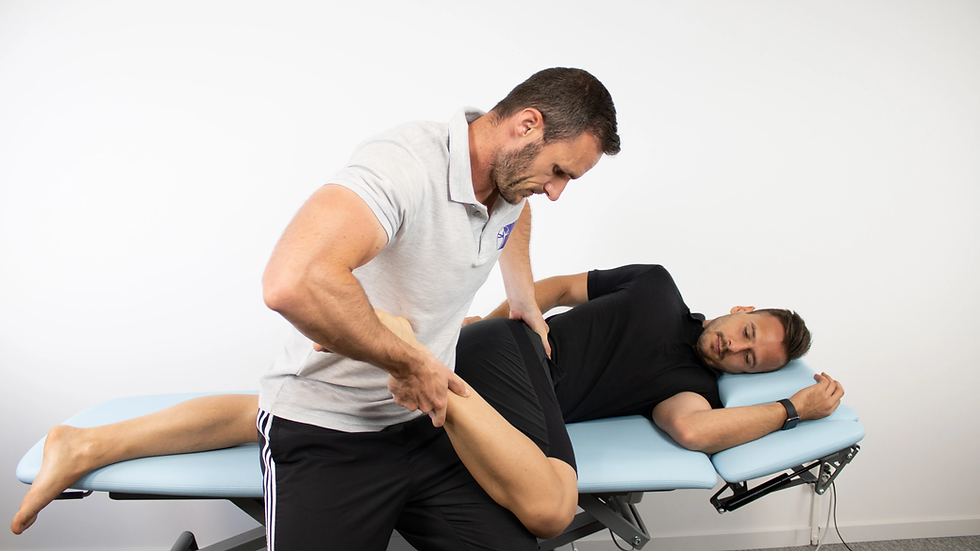FAIR Test
- Fysiobasen

- Oct 3
- 3 min read
The FAIR Test, also known as the Piriformis Test, is used to evaluate irritation or compression of the sciatic nerve caused by the piriformis muscle. It is a specific clinical test often applied in the assessment of piriformis syndrome [1].
Piriformis syndrome occurs when the piriformis muscle compresses or irritates the sciatic nerve, resulting in buttock pain, radiating symptoms into the lower limb, and in some cases, sensory disturbances along the sciatic nerve distribution [2][3].

Anatomical basis
Piriformis muscle: A flat, deep gluteal muscle that is part of the lateral rotator group of the hip, alongside obturator internus, superior and inferior gemelli, quadratus femoris, obturator externus, and gluteus maximus [1].
Sciatic nerve relationship: Normally passes beneath piriformis, but anatomical variations may predispose individuals to compression [4]:
Normal anatomy: Sciatic nerve passes below piriformis.
Variation: The nerve may pass through or above the muscle, increasing the risk of entrapment.
Test procedure
Patient position
The patient lies in a side-lying position with the tested hip on top.
Execution
The examiner passively moves the patient’s hip into:
Flexion (≈90°)
Adduction
Internal rotation
The examiner stabilizes the pelvis and applies a downward pressure on the knee to further internally rotate and adduct the hip [5][6].
Interpretation
Positive test:
Buttock pain → Suggestive of piriformis syndrome.
Radiating pain along the sciatic nerve → Indicates sciatic nerve compression.
Negative test:
No reproduction of pain or neural symptoms.
Test variations
Supine FAIR Test: Patient lies on the back, with hip and knee flexed while resisting external rotation and abduction.
Seated FAIR Test: Patient sits with hip and knee flexed, resisting external hip rotation.
Clinical interpretation
Finding | Possible indication |
Buttock/gluteal pain | Piriformis syndrome (sciatic nerve compressed by piriformis) |
Radiating pain into the lower limb | Sciatic nerve irritation/compression |
Anterior hip or thigh pain | Possible femoroacetabular impingement (FAI) |
Because the FAIR Test may provoke pain from other hip structures such as the labrum or joint capsule, localization of symptoms through palpation, range of motion testing, and differential diagnostics is essential [7][8].
Diagnostic validity and evidence
The FAIR Test demonstrates good sensitivity and specificity for piriformis syndrome.
It should not be used in isolation, but combined with:
Palpation of piriformis (localized tenderness).
Range of motion testing (limited hip rotation).
Neurodynamic tests (to differentiate lumbar radiculopathy vs piriformis syndrome).
Clinical relevance
The FAIR Test is widely used in practice as a provocative maneuver for piriformis syndrome.
It is especially helpful in patients presenting with sciatica-like symptoms where lumbar radiculopathy has been ruled out.
A positive FAIR Test should always be interpreted alongside patient history, functional testing, and imaging if needed.
Conclusion
The FAIR Test is an effective clinical tool for evaluating piriformis syndrome and identifying sciatic nerve compression caused by the piriformis muscle. While it has high specificity, it should be performed in combination with other clinical tests to differentiate piriformis syndrome from other causes of sciatica, such as lumbar disc herniation or intra-articular hip pathology.
References
Oatis, C. A., (2009). Kinesiology : the mechanics and pathomechanics of human movement (2nd ed). Baltimore : Lippincott Williams & Wilkins.
Piriformis. (2017, June 6). Physiopedia, . Retrieved 09:52, December 15, 2017 from https://www.physio-pedia.com/index.php?title=Piriformis&oldid=174010.
http://teachmeanatomy.info/lower-limb/muscles/gluteal-region/
From Beaton, L.E. and B.J. Anson. The relation of the sciatic nerve and its subdivisions to the piriformis muscle. Anat. Rec. 70:1-5, 1938
Kirschner JS, Foye PM, Cole JL. Piriformis syndrome, diagnosis and treatment. Muscle Nerve Jul 2009 ; 40(1) : 10-18
Lori A, Boyajian- O’ Neill et al. Diagnosis and Management of Piriformis syndrome : an osteopathic approach. The journal of the American and osteopathic association Nov 2008; 108(11): 657-664.
Pace JB, Nagle D. Piriformis syndrome. West J Med. 1976; 124: 435-439.
Foster MR. Piriformis syndrome. Orthopedics. 2002; 25: 821-825
Benzon HT, Katz JA, Benzon HA, Iqbal MS. Piriformis syndrome: anatomic considerations, a new injection technique and a review of the literature. Anesthesiology. 2003; 98: 1442-1448.
Magee DJ. Orthopedic physical assessment. 3rd ed. Philadelphia. Pa: WB Saunders Co; 1997
Fishman LM, Dombi GW, Michaelsen C, Ringel S, Rozbruch J, Rosner B, et al. Piriformis syndrome: diagnosis, treatment and outcome- a 10 year study (review) Arch Phys Med Rehabil. 2002; 83: 295-301.
Neumann, Donald. Kinesiology of the Musculoskeletal System: Foundations for Rehabilitation. 2nd edition. St. Louis, MO: Mosby Elsevier, 2010. 498. Print.
Jari S, Paton RW, Srinivasan MS. "Unilateral limitation of abduction of the hip: A valuable clinical sign for DDH?" J Bone Joint Surg2002; 84-B: 104-107. Web. 08/25/2012.









